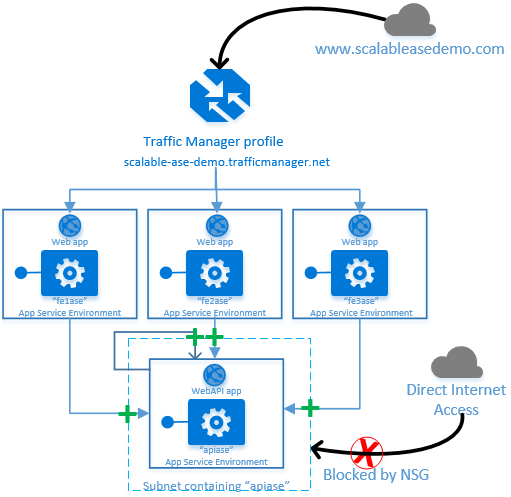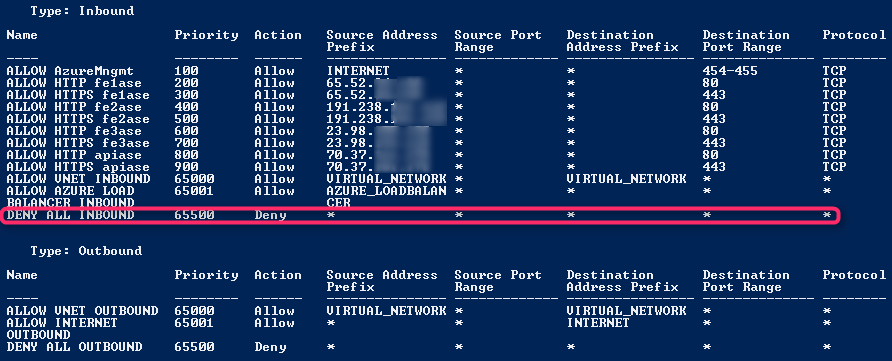實作具有 App Service 環境的多層式安全性架構。
重要
這篇文章是關於 App Service 環境 v1。 App Service 環境 v1 將於 2024 年 8 月 31 日淘汰。 有較新版本的 App Service 環境,其更易於使用,並且是在更強大的基礎結構上執行。 若要深入了解新版本,請從 App Service 環境簡介開始。 如果您目前使用 App Service 環境 v1,請遵循此文章中的步驟來移轉至新版本。
自 2024 年 1 月 29 日起,您無法再使用任何可用的方法建立新的 App Service 環境 v1 資源,包括 ARM/Bicep 範本、Azure 入口網站、Azure CLI 或 REST API。 您必須在 2024 年 8 月 31 日之前移轉至 App Service 環境 v3,以避免資源刪除和資料遺失。
由於 App Service 環境提供部署至虛擬網路的隔離執行階段環境,因此開發人員能夠建立多層式安全性架構,針對每個實體應用程式層提供不同層級的網路存取。
常見的需求之一,是要隱藏對 API 後端的一般網際網路存取,而只允許由上游 Web 應用程式呼叫 API。 網路安全性群組 (NSG) 可用於包含 App Service 環境的子網路,用以限制對 API 應用程式的公用存取。
下圖顯示的範例架構,具有部署在 App Service 環境上的 WebAPI 型應用程式。 三個不同的 Web 應用程式執行個體部署在三個不同的 App Service 環境上,使後端呼叫相同的 WebAPI 應用程式。

綠色加號指出包含 "apiase" 之子網路上的網路安全性群組,允許來自於上游 Web 應用程式的傳入呼叫,及其本身的呼叫。 不過,相同的網路安全群組明確拒絕網際網路對一般輸入流量的存取。
此文的其餘部分將逐步解說在包含 "apiase" 的子網路上設定網路安全群組所需的步驟。
判斷網路行為
若要知道需要哪些網路安全性規則,您必須判斷哪些網路用戶端將能夠聯繫包含 API 應用程式的 App Service 服務環境,而哪些用戶端將遭到封鎖。
由於網路安全性群組 (NSG) 會套用至子網路,而 App Service 環境會部署在子網路中,因此 NSG 中包含的規則將會套用至所有在 App Service 環境上執行的應用程式。 舊本文的範例架構而言,一旦將網路安全性群組套用至包含 "apiase" 的子網路後,所有在 "apiase" App Service 環境上執行的應用程式都將受到相同安全性規則集的保護。
- 判斷上游呼叫端的輸出 IP 位址: 上游呼叫端的 IP 位址為何? 這些位址在 NSG 中必須明確地允許存取。 由於 App Service 環境之間的呼叫會被視為「網際網路」呼叫,所以指派給這三個上游 App Service 環境的輸出 IP 位址,在 "apiase" 子網路的 NSG 中必須是允許存取的。 若想進一步了解如何判斷在 App Service 環境中執行之應用程式的輸出 IP 位址,請參閱網路架構概觀文章。
- 後端 API 應用程式是否需要呼叫本身? 後端應用程式有時候需要呼叫本身,這是常會被忽略而難以察覺的情況。 如果 App Service 環境上的後端 API 應用程式需要呼叫本身,也會將其視為「網際網路」呼叫。 在範例架構中,這必須允許 "apiase" App Service 環境的輸出 IP 位址進行存取。
設定網路安全性群組
得知輸出 IP 位址集後,下一步是要建構網路安全群組。 您可以針對以 Resource Manager 為基礎的虛擬網路以及傳統虛擬網路建立網路安全性群組。 下列範例說明如何在傳統虛擬網路上,使用 PowerShell 來建立和設定 NSG。
在範例架構中,環境位於美國中南部,因此會在該區域中建立空的 NSG:
New-AzureNetworkSecurityGroup -Name "RestrictBackendApi" -Location "South Central US"
-Label "Only allow web frontend and loopback traffic"
首先如 App Service 環境的輸入流量相關文章所說明,要為 Azure 管理基礎結構新增明確的允許規則。
#Open ports for access by Azure management infrastructure
Get-AzureNetworkSecurityGroup -Name "RestrictBackendApi" | Set-AzureNetworkSecurityRule -Name "ALLOW AzureMngmt"
-Type Inbound -Priority 100 -Action Allow -SourceAddressPrefix 'INTERNET' -SourcePortRange '*'
-DestinationAddressPrefix '*' -DestinationPortRange '454-455' -Protocol TCP
接著要新增兩個規則,以允許從第一個上游 App Service 環境 ("fe1ase") 進行 HTTP 和 HTTPS 呼叫。
#Grant access to requests from the first upstream web front-end
Get-AzureNetworkSecurityGroup -Name "RestrictBackendApi" | Set-AzureNetworkSecurityRule -Name "ALLOW HTTP fe1ase"
-Type Inbound -Priority 200 -Action Allow -SourceAddressPrefix '65.52.xx.xyz' -SourcePortRange '*'
-DestinationAddressPrefix '*' -DestinationPortRange '80' -Protocol TCP
Get-AzureNetworkSecurityGroup -Name "RestrictBackendApi" | Set-AzureNetworkSecurityRule -Name "ALLOW HTTPS fe1ase"
-Type Inbound -Priority 300 -Action Allow -SourceAddressPrefix '65.52.xx.xyz' -SourcePortRange '*'
-DestinationAddressPrefix '*' -DestinationPortRange '443' -Protocol TCP
為第二個和第三個上游 App Service 環境 ("fe2ase" 和 "fe3ase") 重複整個流程。
#Grant access to requests from the second upstream web front-end
Get-AzureNetworkSecurityGroup -Name "RestrictBackendApi" | Set-AzureNetworkSecurityRule -Name "ALLOW HTTP fe2ase"
-Type Inbound -Priority 400 -Action Allow -SourceAddressPrefix '191.238.xyz.abc' -SourcePortRange '*'
-DestinationAddressPrefix '*' -DestinationPortRange '80' -Protocol TCP
Get-AzureNetworkSecurityGroup -Name "RestrictBackendApi" | Set-AzureNetworkSecurityRule -Name "ALLOW HTTPS fe2ase"
-Type Inbound -Priority 500 -Action Allow -SourceAddressPrefix '191.238.xyz.abc' -SourcePortRange '*'
-DestinationAddressPrefix '*' -DestinationPortRange '443' -Protocol TCP
#Grant access to requests from the third upstream web front-end
Get-AzureNetworkSecurityGroup -Name "RestrictBackendApi" | Set-AzureNetworkSecurityRule -Name "ALLOW HTTP fe3ase"
-Type Inbound -Priority 600 -Action Allow -SourceAddressPrefix '23.98.abc.xyz' -SourcePortRange '*'
-DestinationAddressPrefix '*' -DestinationPortRange '80' -Protocol TCP
Get-AzureNetworkSecurityGroup -Name "RestrictBackendApi" | Set-AzureNetworkSecurityRule -Name "ALLOW HTTPS fe3ase"
-Type Inbound -Priority 700 -Action Allow -SourceAddressPrefix '23.98.abc.xyz' -SourcePortRange '*'
-DestinationAddressPrefix '*' -DestinationPortRange '443' -Protocol TCP
最後,授與後端 API 的 App Service 環境輸出 IP 位址的存取權,使其能夠回呼本身。
#Allow apps on the apiase environment to call back into itself
Get-AzureNetworkSecurityGroup -Name "RestrictBackendApi" | Set-AzureNetworkSecurityRule -Name "ALLOW HTTP apiase"
-Type Inbound -Priority 800 -Action Allow -SourceAddressPrefix '70.37.xyz.abc' -SourcePortRange '*'
-DestinationAddressPrefix '*' -DestinationPortRange '80' -Protocol TCP
Get-AzureNetworkSecurityGroup -Name "RestrictBackendApi" | Set-AzureNetworkSecurityRule -Name "ALLOW HTTPS apiase"
-Type Inbound -Priority 900 -Action Allow -SourceAddressPrefix '70.37.xyz.abc' -SourcePortRange '*'
-DestinationAddressPrefix '*' -DestinationPortRange '443' -Protocol TCP
不需要任何其他網路安全性,因為依預設每個 NSG 有一組預設規則會封鎖來自網際網路的輸入存取。
網路安全性群組中的完整規則清單顯示如下。 請留意最後一個規則 (反白顯示) 如何封鎖來自所有呼叫端 (已明確獲取存取權的呼叫端除外) 的輸入存取。

最後一個步驟是將 NSG 套用至包含 "apiase" App Service 環境的子網路。
#Apply the NSG to the backend API subnet
Get-AzureNetworkSecurityGroup -Name "RestrictBackendApi" | Set-AzureNetworkSecurityGroupToSubnet
-VirtualNetworkName 'yourvnetnamehere' -SubnetName 'API-ASE-Subnet'
NSG 套用至子網路後,將只有三個上游 App Service 環境以及包含 API 後端的 App Service 環境能夠呼叫 "apiase" 環境。
其他連結和資訊
關於 網路安全性群組的資訊。
了解輸出 IP 位址和 App Service 環境。
App Service 環境所使用的網路連接埠。
注意
如果您想要在註冊 Azure 帳戶前先開始使用 Azure App Service,請前往試用應用程式服務,您可以在應用程式服務中立即建立暫時的入門 Web 應用程式。 無需信用卡,也無需簽定合約。